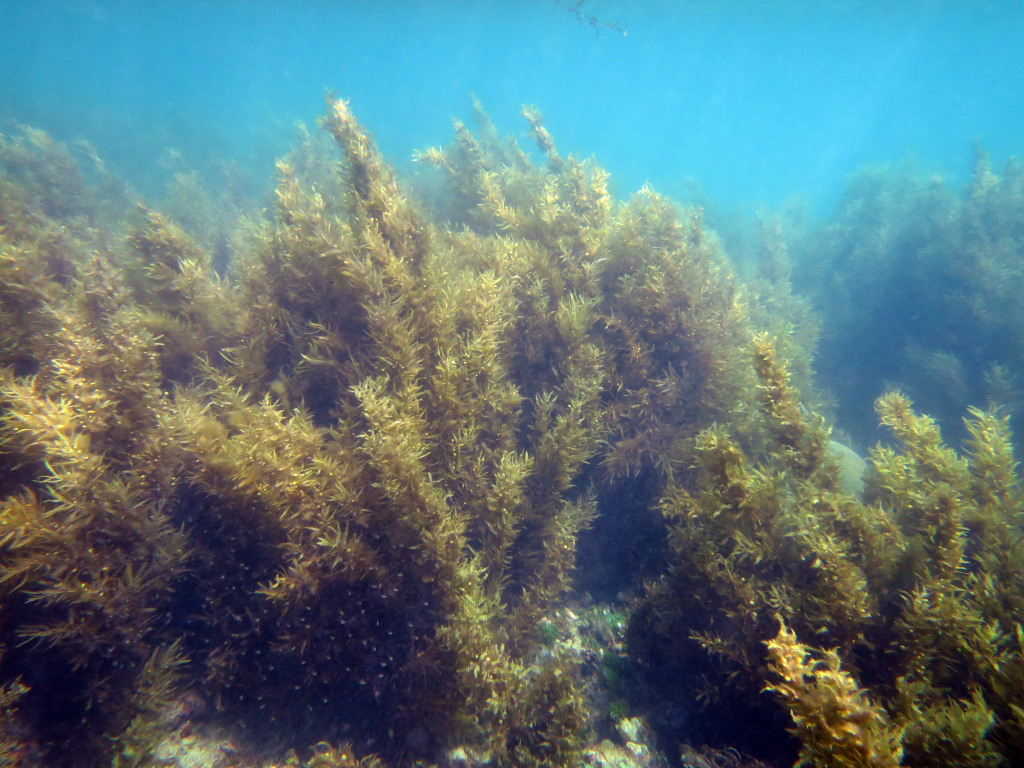|
|
Erect non-calcareous algae (macrophytes)Short descriptionEcosystems dominated by subtidal macrophytic algae with an erect growth form. Disclaimer: Ecosystem type descriptions are based on biophysical attributes identified in Central Queensland through expert advice and supported by scientific literature. Not all ecosystem types are mapped based on current inventory, and many of the ecosystems described here may also occur in other parts of Queensland.
Classification categoriesSelect from the links below to view related ecosystem type categories Long descriptionEcosystems dominated by subtidal macrophytic algae (seaweed) with an erect growth form and a high level of cellular differentiation[8], on any substrate type (irrespective of consolidation). Erect macrophytic algae are usually more than 10 millimetres high and include brown algae (e.g. genera Padina, Sargassum, Lobophora, Dictyota), green algae (e.g. genera Chlorodesmium, Ulva sea lettuce, Caulerpa) or red algae (e.g. genera Asparagopsis)[6]. The kelp Ecklonia radiata is a canopy-forming brown alga that is a keystone species of temperate reefs in Australia, New Zealand and South Africa[1]. These algae are relatively anatomically complex, having specialized attachment structures to attach to the sea floor, including consolidated surfaces such as coral rubble, carbonate pavement or rock but lack roots for attachment[6]. These ecosystems may form a tall canopy that overshadows biota living on the bottom, or alternately a short canopy, depending on the seasonal factors, herbivory, nutrients and other factors that effect growth[7] Macroalgae are a prominent component of consolidated ecosystems, including coral reefs. There are interactions between coral ecosystems and macroalgal ecosystems such that many coral reefs have shifted away from coral dominance to assemblages that include macroalgae. Causal relationships between fishing and eutrophication of waters have been implicated[2]. Macroalgae such as Sargassum spp. are associated with inshore coral reefs, colonising after disturbance and forming regular association with degraded reefs[3][4]. Special valuesMacroalgae provide a major food source, cover and nurseries for herbivorous fish and other species[7]. Sargassum beds on coral reefs are intermittently and seasonally either tall or short in structure. The tall structure provides three-dimensional space for understorey algae and for fish to shelter, followed by short structure created by storms and cyclones detaching the canopy, washing it up onto the shore as debris (wrack)[7]. Kelp forests are recognised as global biodiversity hotspots for many taxa including other seaweeds, sponges, crustaceans, chordates, bryozoans, echinoderms and molluscs. They are also important fish habitats, facilitating connectivity for mobile fish species. Kelp forests may be isolated from each other and the taxa living in them are often highly endemic[1]. Diagnostic attributesInundation 'Subtidal' Structural macrobiota 'Algae – erect macrophyte' QualifiersAlthough unmapped, Period and Trend qualifiers are relevant as macroalgal growth can be seasonal and ephemeral. After a disturbance event such as floods, cyclones and coral bleaching macroalgae is often the first coloniser of impacted coral or seagrass ecosystems. DistributionErect macrophytic algae are found throughout Queensland waters and are part of many ecosystem types. Kelp beds Ecklonia radiata are at their northern limits and found in very deep (greater than 60 metres) shelf waters south of Moreton Island where they may be linked with upwelling events[9]. The following relates to distribution of this ecosystem type within the Central Queensland mapping area:
CommentsOther relevant attributes are those of the water column: Water temperature; Water clarity; and Benthic depth (as related to light). Energy source (upwellings) and Energy magnitude are especially relevant to the distribution of kelp forests[9]. Additional InformationSaltmarshes, seagrasses and algae - Queensland Department of Primary Industries Algae and algae blooms - Queensland Government Harmful algae - Queensland Government References
Last updated: 22 July 2019 This page should be cited as: Department of Environment, Science and Innovation, Queensland (2019) Erect non-calcareous algae (macrophytes), WetlandInfo website, accessed 8 May 2025. Available at: https://wetlandinfo.des.qld.gov.au/wetlands/ecology/aquatic-ecosystems-natural/estuarine-marine/descriptions/55/ |

 — Department of the Environment, Tourism, Science and Innovation
— Department of the Environment, Tourism, Science and Innovation


